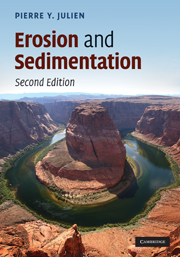Book contents
- Frontmatter
- Contents
- Preface
- List of Symbols
- 1 Introduction
- 2 Physical properties and dimensional analysis
- 3 Mechanics of sediment-laden flows
- 4 Particle motion in inviscid fluids
- 5 Particle motion in Newtonian fluids
- 6 Turbulent velocity profiles
- 7 Incipient motion
- 8 Bedforms
- 9 Bedload
- 10 Suspended load
- 11 Total load
- 12 Reservoir sedimentation
- Appendix A Einstein's Sediment Transport Method
- Appendix B Useful mathematical relationships
- Bibliography
- Index
9 - Bedload
Published online by Cambridge University Press: 05 June 2012
- Frontmatter
- Contents
- Preface
- List of Symbols
- 1 Introduction
- 2 Physical properties and dimensional analysis
- 3 Mechanics of sediment-laden flows
- 4 Particle motion in inviscid fluids
- 5 Particle motion in Newtonian fluids
- 6 Turbulent velocity profiles
- 7 Incipient motion
- 8 Bedforms
- 9 Bedload
- 10 Suspended load
- 11 Total load
- 12 Reservoir sedimentation
- Appendix A Einstein's Sediment Transport Method
- Appendix B Useful mathematical relationships
- Bibliography
- Index
Summary
Non-cohesive bed particles enter motion as soon as the shear stress applied on the bed material exceeds the critical shear stress. Generally, silt and clay particles enter suspension (see Chapter 10), and sand and gravel particles roll and slide in a thin layer near the bed called the bed layer. The bed layer thickness is typically less than 1 mm in sand-bed channels, up to tens of centimeters in gravel-bed streams. Note that the bed layer thickness should not be mistaken for the laminar sublayer thickness defined in Chapter 6. As sketched in Figure 9.1, the bed layer thickness a is a few grain diameters thick, and a = 2 ds has been commonly used. Bedload, or contact load, refers to the transport of sediment particles which frequently maintain contact with the bed. Bedload transport can be treated either as a deterministic or a probabilistic problem. Deterministic methods have been proposed by DuBoys and Meyer-Peter Müller; probabilistic methods were developed by Kalinske and Einstein. Both approaches yield satisfactory estimates of bedload discharge, as discussed in Section 9.1. The characteristics of the bed layer are described in Section 9.2. Bed material sampling is discussed in Section 9.3 and bed sediment discharge measurement techniques are summarized in Section 9.4.
Bedload Lb refers to a quantity of sediment that is moving in the bed layer, which can be measured by volume, mass, or weight.
- Type
- Chapter
- Information
- Erosion and Sedimentation , pp. 195 - 215Publisher: Cambridge University PressPrint publication year: 2010



